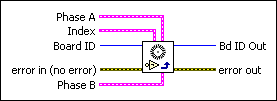 |
Phase A sets the polarity for encoder Phase A to active low or active high.
 |
Encoder 1—If true, active high (default). If false, active low. |
 |
Encoder 2—If true, active high (default). If false, active low. |
 |
Encoder 3—If true, active high (default). If false, active low. |
 |
Encoder 4—If true, active high (default). If false, active low. |
 |
Encoder 5—If true, active high (default). If false, active low. |
 |
Encoder 6—If true, active high (default). If false, active low. |
 |
Encoder 7—If true, active high (default). If false, active low. |
 |
Encoder 8—If true, active high (default). If false, active low. |
|
 |
Index sets the polarity for the encoder Index to active low or active high.
 |
Encoder 1—If true, active high (default). If false, active low. |
 |
Encoder 2—If true, active high (default). If false, active low. |
 |
Encoder 3—If true, active high (default). If false, active low. |
 |
Encoder 4—If true, active high (default). If false, active low. |
 |
Encoder 5—If true, active high (default). If false, active low. |
 |
Encoder 6—If true, active high (default). If false, active low. |
 |
Encoder 7—If true, active high (default). If false, active low. |
 |
Encoder 8—If true, active high (default). If false, active low. |
|
 |
Board ID is a unique number assigned by Measurement & Automation Explorer (MAX) used to send and receive commands and data to or from a specific NI motion controller. |
 |
error in (no error) describes error conditions that occur before this VI runs. The default input of this cluster is no error. If an error already occurred, this VI returns the value of error in in error out. The VI runs normally only if no incoming error exists. Otherwise, the VI passes the error in value to error out. The error in cluster contains the following parameters:
 |
status is TRUE if an error occurred before this VI was called, or FALSE if not. If status is TRUE, code is a nonzero error code. If status is FALSE, code is zero or a warning code.
|
 |
code is a number identifying an error or warning. If status is TRUE, code is a nonzero error code. If status is FALSE, code is zero or a warning code. Use the error handler VIs to look up the meaning of this code and display the corresponding error message.
|
 |
source is a string that indicates the origin of the error, if any. Typically, source is the name of the VI in which the error occurred.
|
|
 |
Phase B sets the polarity for encoder Phase B to active low or active high.
 |
Encoder 1—If true, active high (default). If false, active low. |
 |
Encoder 2—If true, active high (default). If false, active low. |
 |
Encoder 3—If true, active high (default). If false, active low. |
 |
Encoder 4—If true, active high (default). If false, active low. |
 |
Encoder 5—If true, active high (default). If false, active low. |
 |
Encoder 6—If true, active high (default). If false, active low. |
 |
Encoder 7—If true, active high (default). If false, active low. |
 |
Encoder 8—If true, active high (default). If false, active low. |
|
 |
Bd ID Out is provided for flow control. You can string together NI-Motion VIs by wiring the Board ID Out terminal of one VI to the Board ID terminal of the next VI. |
 |
error out contains error information. If error in indicates an error, error out contains the same error information. Otherwise, it describes the error status that this VI produces.
 |
status is TRUE if an error occurred, or FALSE if not. If status is TRUE, code is a nonzero error code. If status is FALSE, code is zero or a warning code.
|
 |
code is a number identifying an error or warning. If status is TRUE, code is a nonzero error code. If status is FALSE, code is zero or a warning code. Use
the error handler VIs to look up the meaning of this code and
display the corresponding error message. |
 |
source is a string that indicates the origin of the error, if any. Typically, source is the name of the VI in which the error occurred. |
|
You can configure the encoder polarity as active low or active high. When configured as active low, the input is active when there is a low signal on the input pin. Conversely, active high means that the input is active when there is a high signal on the input pin.














